补题与总结:牛客小白月赛83(B~F)
写在最前面的复盘

出了ABCD,犯的最大错误就是读假题,ABE都读假了。赛后一想确实读题太急,也没通过用例验证题意
C是一道简单概率题,可能是高中数学考试填空第一题吧,数学忘的太快,概率这块练的也少,好在最后推出来了
赛时却wa穿了D,没想到正解,用了暴力超时,发现答案的数量远远低于询问的数量,想用记忆化优化,接着wa穿。每次读出一个错误就直接交,然后继续wa,还是太着急了,很多代码的细节没有写好就想着交了。赛后看到正解,将
O
(
n
2
)
O(n^2)
O(n2)的枚举优化到
O
(
n
)
O(n)
O(n)的思路很值得学习
E,
O
(
n
)
O(n)
O(n)找下一个不同字符的下标,用set优化成
O
(
l
n
g
n
)
O(lngn)
O(lngn)也值得学习
F,补题时wa穿,对于我目前的实力还是略难了,就算赛时能利用题目性质和数据范围推导出结论,最后的代码实现也会漏掉很多细节,因为要考虑很多边界和结论的性质。但总的来说,推导结论的过程还是值得学习的
B-小天的魔法(贪心 模拟 双指针)
B-小天的魔法_牛客小白月赛83 (nowcoder.com)
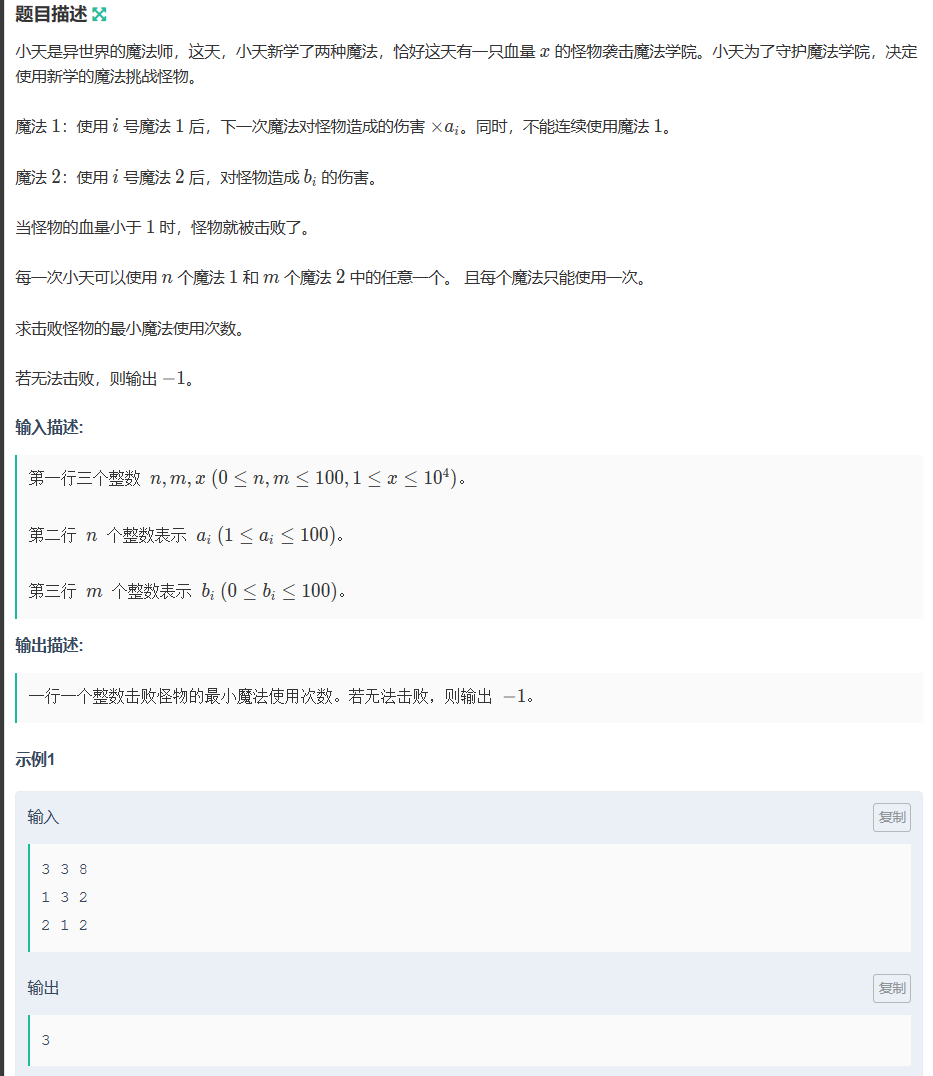
用数组a,b存储题目给定的两个序列,并对其降序排序。用i,j两个指针分别指向a,b数组的第一个元素
贪心思路:考虑使用
b
j
b_j
bj?之前是否要使用
a
i
a_i
ai?,若
a
i
a_i
ai? != 1,则先使用
a
i
a_i
ai?再使用
b
j
b_j
bj?
证明:使用次数相同时,比较
a
i
?
b
j
a_i * b_j
ai??bj?与
b
j
+
b
j
+
1
b_j + b_{j + 1}
bj?+bj+1?的大小。显然
a
i
a_i
ai?不为1时,有以下关系
a
i
?
b
j
>
=
b
j
+
b
j
>
=
b
j
+
b
j
+
1
a_i * b_j >= b_j + b_j >= b_j + b_{j+1}
ai??bj?>=bj?+bj?>=bj?+bj+1?
显然使用两次b魔法造成的伤害小于等于先使用a再使用b,证明完毕
注意:若直接使用 b j b_j bj?就能击败怪物,则直接使用 b j b_j bj?
#include <bits/stdc++.h>
using namespace std;
const int N = 3e5 + 10;
int a[N], b[N];
void solve()
{
int n, m, x; cin >> n >> m >> x;
for (int i = 1; i <= n; ++ i) cin >> a[i];
for (int i = 1; i <= m; ++ i) cin >> b[i];
sort(a + 1, a + n + 1, greater<int>()), sort(b + 1, b + n + 1, greater<int>());
int i = 1, j = 1;
int cur = 0, cnt = 0;
while (j <= m)
{
if (cur >= x) break;
// 直接使用b[j]就能击败怪物
if (j <= m && cur + b[j] >= x) cur += b[j ++ ], cnt ++ ;
// 当a[i] != 1时,贪心
else if (i <= n && a[i] != 1) cnt += 2, cur += a[i ++ ] * b[j ++ ];
else if (j <= m) cnt ++ , cur += b[j ++ ];
}
if (cur >= x) cout << cnt << "\n";
else cout << "-1\n";
}
int main()
{
ios::sync_with_stdio(false), cin.tie(0),cout.tie(0);
solve();
return 0;
}
C-小天的 Minecraft(概率)
C-小天的 Minecraft_牛客小白月赛83 (nowcoder.com)
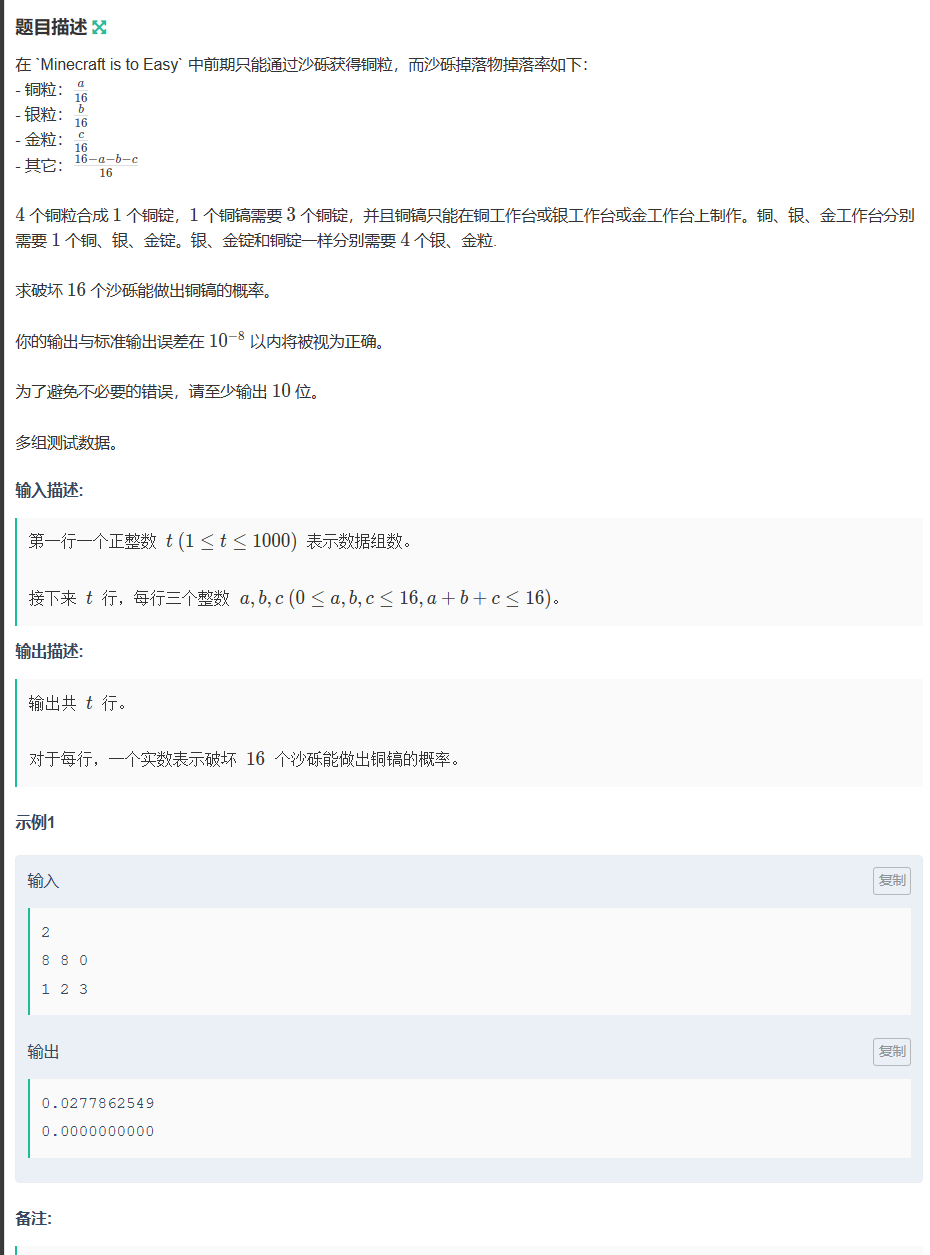
生成铜稿首先要12个铜粒,其次需要一个工作台。工作台有三种情况:铜、银、金
铜工作台需要4个铜粒,银的需要4个银粒,金的需要4个金粒
显然,有三种情况能生成铜稿
- 12个铜粒+铜工作台:16个铜粒
- 12个铜粒+银工作台:12个铜粒+4个银粒
- 12个铜粒+金工作台:12个铜粒+4个金粒
假设事件发生的概率为p,重复m次该事件,发生n次p的概率为:
C
m
n
?
p
n
C_m^n * p^n
Cmn??pn
p
a
p_a
pa?、
p
b
p_b
pb?、
p
c
p_c
pc?分别为掉落铜粒、银粒、金粒的概率,那么以上三种情况的概率为:
- C 16 16 ? p a 16 C_{16}^{16} * p_a^{16} C1616??pa16?
- C 16 12 ? p a 12 + C 16 4 ? p b 4 C_{16}^{12} * p_a^{12} + C_{16}^{4} * p_b^4 C1612??pa12?+C164??pb4?
- C 16 12 ? p a 12 + C 16 4 ? p c 4 C_{16}^{12} * p_a^{12} + C_{16}^{4} * p_c^4 C1612??pa12?+C164??pc4?
将三种情况的概率相加即为答案(代码丑陋,看思路自己写就行)
#include <bits/stdc++.h>
using namespace std;
void solve()
{
int T; cin >> T;
while (T --)
{
double a, b, c; cin >> a >> b >> c;
a /= 16, b /= 16, c /= 16;
double ans = 1;
double t = 1;
for (int i = 0; i < 12; ++ i) t *= a;
for (int i = 0; i < 16; ++ i) ans *= a;
double t1 = 1, t2 = 1, t3 = 1;
for (int i = 0; i < 4; ++ i) t1 *= a, t2 *= b, t3 *= c;
ans += t * (t2 + t3) * 4 * 5 * 7 * 13; // 4 * 5 * 7 * 13为C_16^4的值
printf("%.12lf\n", ans);
}
}
int main()
{
solve();
return 0;
}
D-小天的子序列(预处理 排列组合)
D-小天的子序列_牛客小白月赛83 (nowcoder.com)
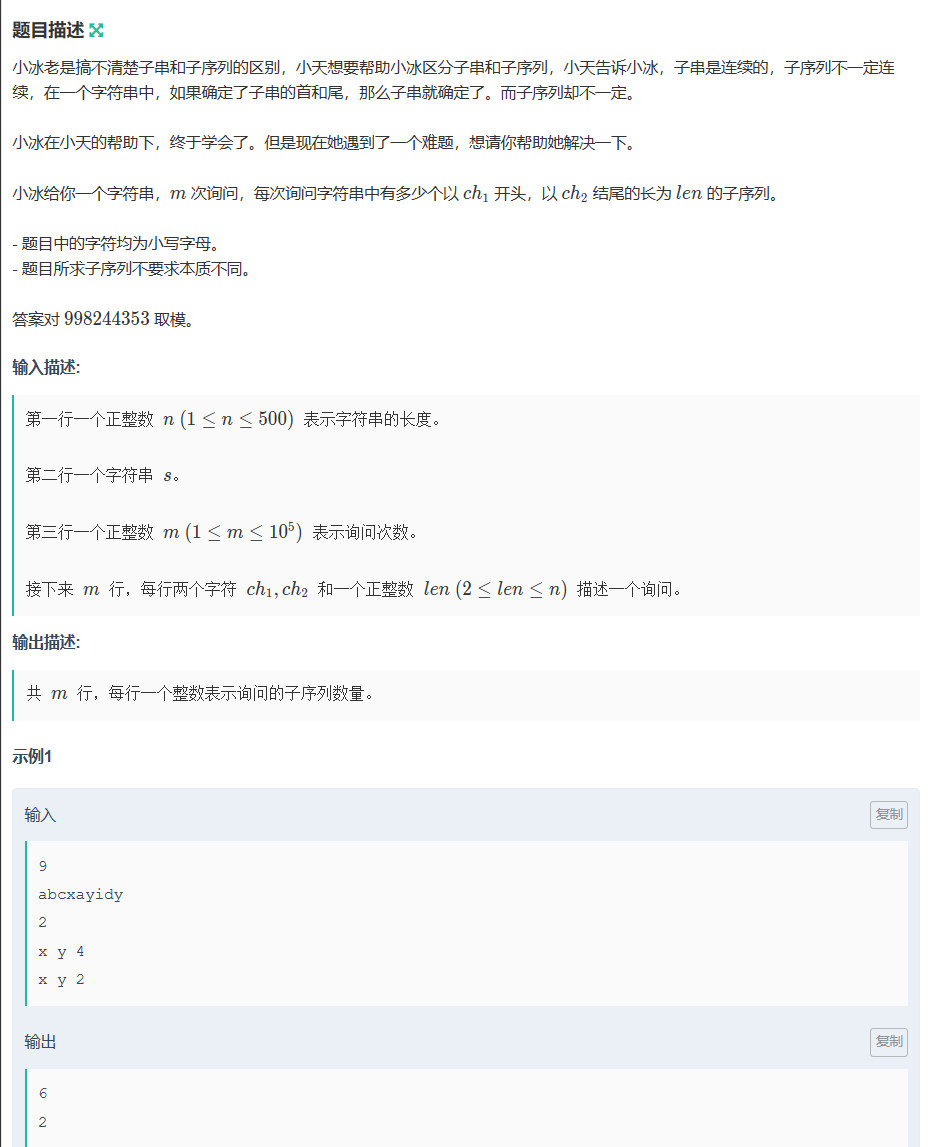
假设以ch1为开头,ch2为结尾的字符串长度为n,那么满足条件的子序列数量为
C
n
?
2
l
e
n
?
2
C_{n-2}^{len-2}
Cn?2len?2?
根据数据范围,需要预处理组合数
C
m
n
C_m^n
Cmn?,1<=m <=500, 1<=n<=500
模板为:
for (int i = 0; i < N; ++ i) c[i][0] = 1;
for (int i = 1; i < N; ++ i)
for (int j = 1; j <= i; ++ j)
c[i][j] = (c[i - 1][j] + c[i - 1][j - 1]) % 998244353;
接着就是找字符串中的满足条件子串:以ch1为开头,ch2为结尾,且长度大于len
由于字符串最大长度为500,直接暴力预处理字符串所有子串的情况
用cnt[26][26][500]保存所有子串的出现次数,如cnt[0][3][2] = 4表示:整个字符串中,以a(0 = a - a)为开头,以d(3 = d - a)为结尾,且长度为2的子串出现了4次
满足条件的子串为cnt[ch1][ch2][t],len <= t <= 500
对于每次的询问,线性枚举t满足条件的子串出现次数并乘以组合数即可
注意:组合数的预处理数组最好开LL
#include <bits/stdc++.h>
using namespace std;
const int mod9 = 998244353;
const int N = 510;
long long cnt[30][30][N], c[N][N];
void solve()
{
int n; cin >> n;
string s; cin >> s;
s = " " + s;
for (int i = 0; i < N; ++ i) c[i][0] = 1;
for (int i = 1; i < N; ++ i)
for (int j = 1; j <= i; ++ j)
c[i][j] = (c[i - 1][j] + c[i - 1][j - 1]) % mod9;
for (int i = 1; i <= n; ++ i)
for (int j = i + 1; j <= n; ++ j)
cnt[s[i] - 'a'][s[j] - 'a'][j - i + 1] ++ ;
int m; cin >> m;
while (m --)
{
long long ans = 0;
char x, y; cin >> x >> y;
int len; cin >> len;
for (int i = len; i <= n; ++ i)
ans = (ans + c[i - 2][len - 2] * cnt[x - 'a'][y - 'a'][i]) % mod9;
cout << ans << "\n";
}
}
int main()
{
ios::sync_with_stdio(false), cin.tie(0),cout.tie(0);
solve();
return 0;
}
E-小天的贪吃蛇(模拟)
E-小天的贪吃蛇_牛客小白月赛83 (nowcoder.com)
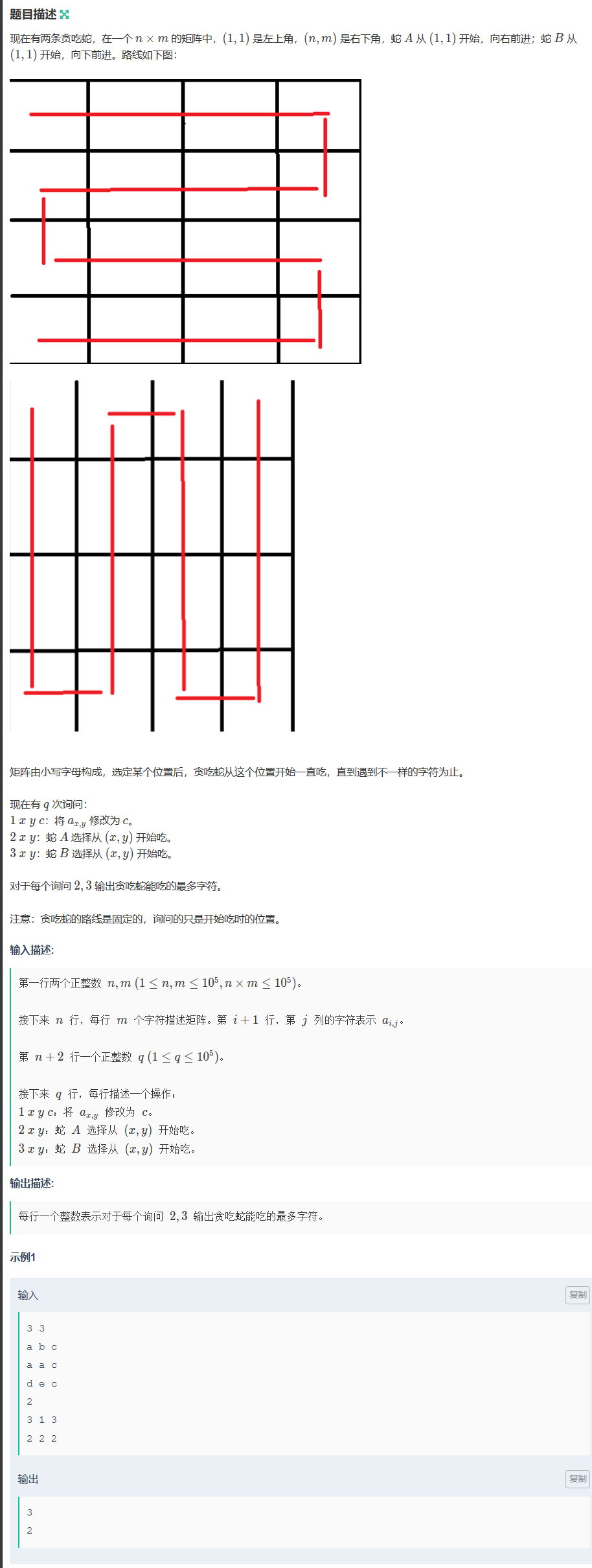
模拟蛇的轨迹,将二维数组转换成一维字符串,保存数组下标与字符串下标之间的映射关系,同时用pos数组保存每个字符在字符串的出现位置(下标)。如pos[1]表示字符b (1 = b - a)在数组中的下标,这些下标用set存储,即set pos[26]
对于修改操作,将二维坐标转换成字符串的下标并修改字符串,同时维护pos数组
对于询问操作,也是将二维坐标转换成字符串的下标,并且获取该下标对应字符。此时在其他字符的出现位置中,找出大于等于(lower_bound)该下标的最小下标,两下标之间的距离为答案
#include <bits/stdc++.h>
using namespace std;
typedef pair<int, int> PII;
typedef long long LL;
typedef unsigned long long ULL;
const int inf = 2e9 + 10;
const LL INF = 4e18 + 10;
const int mod9 = 998244353;
const int mod7 = 1e9 + 7;
const int N = 3e5 + 10;
int n, m;
set<int> pos1[30], pos2[30];
void solve()
{
cin >> n >> m;
vector<vector<char>> g(n + 1, vector<char>(m + 1, 0));
vector<vector<int>> idx1(n + 1, vector<int>(m + 1));
vector<vector<int>> idx2(n + 1, vector<int>(m + 1));
for (int i = 1; i <= n; ++ i)
for (int j = 1; j <= m; ++ j)
cin >> g[i][j];
string s1, s2;
int i = 1, j = 1, dir = 1, cnt = 0;
while (i <= n)
{
s1 += g[i][j], pos1[g[i][j] - 'a'].insert(cnt);
idx1[i][j] = cnt ++ ;
j += dir;
if (j == m + 1) j = m, i ++ , dir *= -1;
if (j == 0) j = 1, i ++, dir *= -1;
}
i = 1, j = 1, dir = 1, cnt = 0;
while (j <= m)
{
s2 += g[i][j], pos2[g[i][j] - 'a'].insert(cnt);
idx2[i][j] = cnt ++ ;
i += dir;
if (i == n + 1) i = n, j ++ , dir *= -1;
if (i == 0) i = 1, j ++ , dir *= -1;
}
int Q; cin >> Q;
while (Q --)
{
int t, x, y; cin >> t >> x >> y;
if (t == 1)
{
char c; cin >> c;
pos1[s1[idx1[x][y]] - 'a'].erase(idx1[x][y]);
pos2[s2[idx2[x][y]] - 'a'].erase(idx2[x][y]);
s1[idx1[x][y]] = c;
s2[idx2[x][y]] = c;
pos1[c - 'a'].insert(idx1[x][y]);
pos2[c - 'a'].insert(idx2[x][y]);
}
else if (t == 2)
{
int c = s1[idx1[x][y]] - 'a';
int ans = inf;
for (int i = 0; i < 26; ++ i)
if (i != c)
{
auto it = pos1[i].lower_bound(idx1[x][y]);
if (it != pos1[i].end())
ans = min(ans, *it);
else ans = min(ans, n * m);
}
cout << ans - idx1[x][y] << "\n";
}
else
{
int c = s2[idx2[x][y]] - 'a';
int ans = inf;
for (int i = 0; i < 26; ++ i)
if (i != c)
{
auto it = pos2[i].lower_bound(idx2[x][y]);
if (it != pos2[i].end())
ans = min(ans, *it);
else ans = min(ans, n * m);
}
cout << ans - idx2[x][y] << "\n";
}
}
}
int main()
{
ios::sync_with_stdio(false), cin.tie(0),cout.tie(0);
solve();
return 0;
}
F-小天的 A+B(结论题)
F-小天的 A+B_牛客小白月赛83 (nowcoder.com)
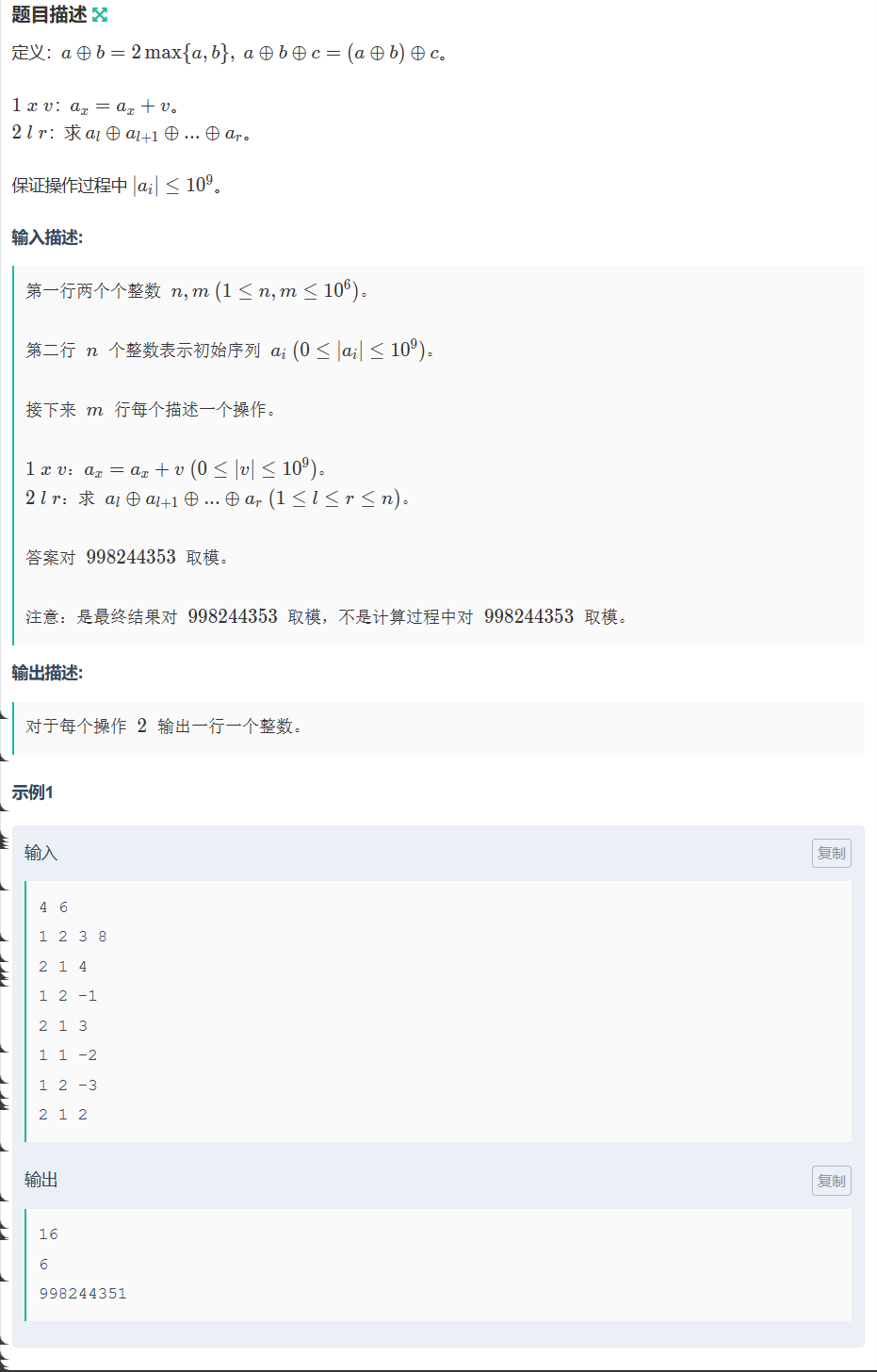
考虑每次操作的特殊性与
a
i
a_i
ai?的数据范围,对于一个长度为32的序列,假设经过运算的答案为ans,那么
a
n
s
=
m
a
x
(
2
30
a
l
,
2
30
a
l
+
1
,
2
29
a
l
+
2
,
2
28
a
l
+
3
,
.
.
.
,
2
1
a
r
?
1
,
2
0
a
r
)
ans=max(2^{30}a_l,2^{30}a_{l+1}, 2^{29}a_{l+2},2^{28}a_{l+3},...,2^1a_{r-1},2^0a_r)
ans=max(230al?,230al+1?,229al+2?,228al+3?,...,21ar?1?,20ar?)
每个
a
i
a_i
ai?之前都乘上了一个系数,并且这个系数随着序列长度的增大而增大,当序列长度为32时,前两个数的系数已经达到
2
30
2^{30}
230。由于
a
i
a_i
ai?的最大值为1e9,而
2
30
>
1
e
9
2^{30}>1e9
230>1e9,所以ans一定大于这个序列之后(
a
r
a_r
ar?之后)的数。总结下,若区间[l, r]的前32个数中,存在一个正数,那么ans就是答案
若前32个数中不存在正数,但存在0,那么0就是答案
若前32个数中既不存在正数也不存在0,由于负数乘2会越来越小,所以需要在[l, r]区间的后32数中求ans
实现起来的细节还是很多的:
#include <bits/stdc++.h>
using namespace std;
typedef long long LL;
const int mod9 = 998244353;
const int N = 1e6 + 10;
LL a[N], b[N];
set<int> pos, zr;
LL f(int st, int l, int r)
{
LL ans = (st == l ? 1 : 2) * a[st];
int pos = st;
while (pos + 1 <= r && pos - st <= 30)
ans = 2 * max(ans, a[++ pos]);
ans %= mod9;
ans = ans * b[r - pos] % mod9;
return (ans % mod9 + mod9) % mod9;
}
void solve()
{
int n, m; cin >> n >> m; b[0] = 1;
for (int i = 1; i <= 1000000; ++ i)
b[i] = b[i - 1] * 2 % mod9;
for (int i = 1; i <= n; ++ i)
{
cin >> a[i];
if (a[i] == 0) zr.insert(i);
else if (a[i] > 0) pos.insert(i);
}
while (m --)
{
int t; cin >> t;
if (t == 1)
{
int x, v; cin >> x >> v;
if (a[x] == 0) zr.erase(x);
else if (a[x] > 0) pos.erase(x);
a[x] += v;
if (a[x] == 0) zr.insert(x);
else if (a[x] > 0) pos.insert(x);
}
else
{
int l, r; cin >> l >> r;
auto it = pos.lower_bound(l);
if (it != pos.end() && *it <= r)
{
cout << f(*it, l, r) << "\n";
continue;
}
it = zr.lower_bound(l);
if (it != zr.end() && *it <= r)
{
cout << "0\n";
continue;
}
cout << f(max(l, r - 30), l, r) << "\n";
}
}
}
int main()
{
ios::sync_with_stdio(false), cin.tie(0),cout.tie(0);
solve();
return 0;
}
本文来自互联网用户投稿,该文观点仅代表作者本人,不代表本站立场。本站仅提供信息存储空间服务,不拥有所有权,不承担相关法律责任。 如若内容造成侵权/违法违规/事实不符,请联系我的编程经验分享网邮箱:chenni525@qq.com进行投诉反馈,一经查实,立即删除!